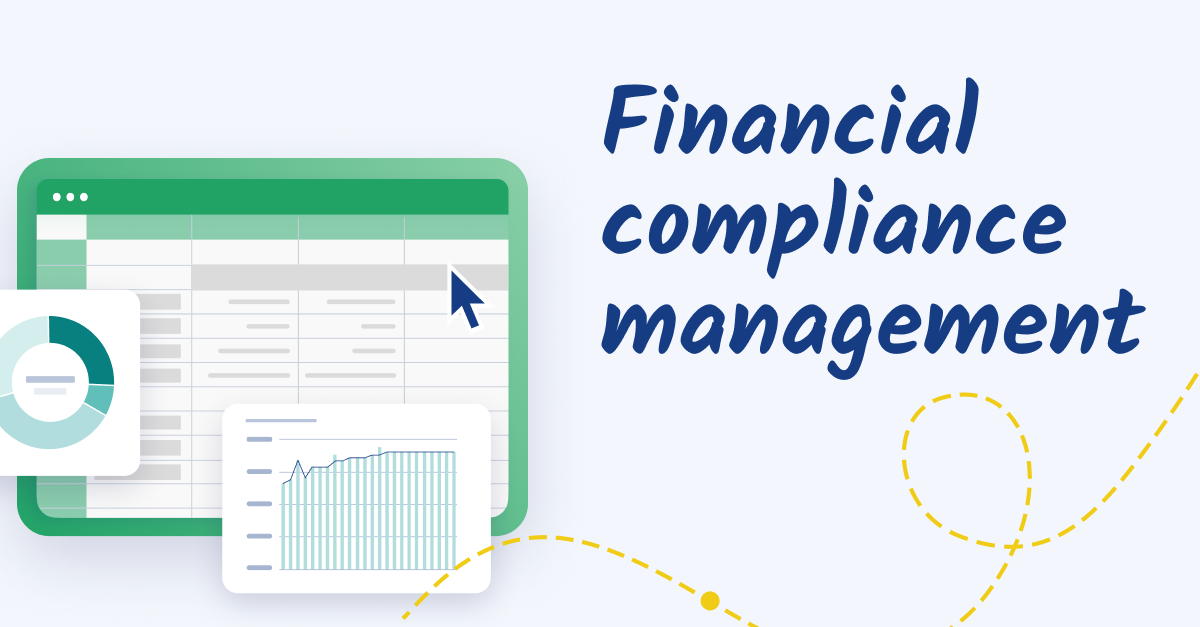What is financial compliance management?
Financial compliance management ensures that an organization follows all relevant regulations, laws, and standards in its financial operations. Key components include:
- Regulatory reporting: Ensures timely and accurate submission of required financial data
- Internal controls: Safeguard against errors and fraud
- Risk management: Identifies and mitigates compliance risks
FP&A leaders play a critical role in maintaining compliance. They're responsible for making sure that financial processes are aligned with regulatory requirements, implementing strong internal controls, and supporting accurate reporting.
Their strategic oversight helps reduce the risk of non-compliance, which can lead to costly penalties and damage to the company’s reputation.

Key regulatory requirements every FP&A leader needs to know
FP&A leaders must be well-versed in specific financial regulations that shape how companies report, control, and manage their finances.
The most critical regulations include the Sarbanes-Oxley Act (SOX), International Financial Reporting Standards (IFRS), Generally Accepted Accounting Principles (GAAP), and various local laws and standards.
- Sarbanes-Oxley Act (SOX): Enacted in response to major corporate scandals, SOX mandates strict internal controls and procedures for financial reporting to prevent fraud. FP&A leaders need to understand these controls to ensure that their organization’s financial data is accurate, transparent, and auditable.
- International Financial Reporting Standards (IFRS): These are global accounting standards used by companies in many countries to ensure consistency and comparability in financial statements. FP&A leaders, especially those working in multinational organizations, need to understand IFRS to manage financial reporting across different regions and comply with international standards.
- Generally Accepted Accounting Principles (GAAP): GAAP refers to the standard framework of guidelines for financial accounting in the United States. FP&A leaders must adhere to GAAP to ensure financial statements are accurate and reflect the true financial position of the company.
Knowing these regulations is essential because non-compliance can have severe consequences. For example, inaccurate financial reports can lead to poor decision-making and flawed forecasts, which could cause a company to miss critical financial goals or face unexpected risks.
Additionally, non-compliance can result in regulatory fines, legal actions, and damage to the company’s reputation, which could have long-term financial impacts.
How to build a strong compliance framework
For FP&A leaders, a robust compliance framework is key to minimizing risks and ensuring smooth regulatory adherence. Here’s how to build an effective compliance structure:
1. Establish clear financial reporting processes
FP&A leaders should ensure that all financial data is accurate, up-to-date, and aligned with regulatory standards like GAAP or IFRS. This starts with streamlining data collection and validation processes across departments to avoid inconsistencies that could lead to compliance breaches.
2. Develop strong internal controls
Implement internal controls that monitor financial activities, such as budgeting, forecasting, and cash flow management. Controls should detect any discrepancies or anomalies in financial reporting early, allowing the FP&A team to address potential compliance risks before they escalate.
3. Collaborate closely with accounting and legal teams
Regular communication with accounting and legal departments is crucial for staying updated on any regulatory changes or new compliance requirements. FP&A leaders should work with these teams to ensure that compliance measures are aligned with both the company’s financial objectives and legal obligations.
4. Integrate compliance into forecasting and planning
FP&A leaders should embed compliance considerations into financial forecasting and long-term planning. This includes accounting for regulatory risks and ensuring that financial models align with all relevant laws and standards. By incorporating compliance into the financial strategy, FP&A leaders can reduce risk exposure and make more informed decisions.
5. Conduct regular compliance audits
Conduct frequent audits of financial data and processes to ensure ongoing adherence to regulations. FP&A leaders should be proactive in identifying gaps in compliance and addressing them through process improvements or additional controls.
6. Leverage technology for compliance
Implement FP&A software that offers automated compliance features, such as real-time data validation and audit trails. Automation can reduce the risk of human error, enhance transparency, and ensure that financial reports are compliant with regulatory standards.

Financial compliance management challenges for FP&A leaders
FP&A leaders face several unique challenges when it comes to financial compliance management, often stretching their focus between regulatory demands and strategic financial planning. Here are some of the most common hurdles:
Staying up-to-date with changing regulations
With regulations constantly evolving, it’s difficult for FP&A leaders to stay current while also managing day-to-day financial operations. This can lead to compliance gaps and increased risk.
A strategy to overcome this is setting up regular check-ins with the legal and accounting teams, leveraging compliance management systems that offer updates on regulatory changes, and attending relevant industry training sessions.
Managing global compliance
For organizations operating across multiple regions, different countries have varying financial regulations and reporting standards, making it challenging to maintain compliance globally.
FP&A leaders can address this by building strong cross-functional teams that include local compliance experts or working with external consultants who specialize in international compliance.
Ensuring data security
With the rise of data breaches and cyber threats, safeguarding sensitive financial data is critical for maintaining compliance.
Implementing strong data security protocols, ensuring that financial systems have encryption and access controls, and conducting regular cybersecurity audits can help FP&A leaders mitigate the risks.
Embedding compliance into financial forecasting and planning
For FP&A leaders, integrating compliance into budgeting, forecasting, and scenario planning is crucial for maintaining regulatory compliance while driving financial performance. It's all part of a strong financial compliance strategy.
Here's how compliance impacts these key functions:
- Budgeting: Compliance costs, such as audit expenses, regulatory fees, and the implementation of new internal controls, should be factored into the budgeting process. FP&A leaders need to ensure these costs are included in the financial plan to avoid unforeseen budget constraints.
- Forecasting: Regulatory changes can impact business operations and financial outcomes, making risk assessment essential when forecasting future revenue, expenses, and cash flow. Considering the potential impact of new laws or standards helps FP&A leaders create more accurate and resilient forecasts.
- Scenario planning: When conducting scenario analysis, it’s important to evaluate how different regulatory outcomes may affect business performance. For example, FP&A teams should explore how stricter data privacy regulations might influence operational costs or how changes in tax law could impact profitability.

Monitoring and reporting for continuous compliance
Once compliance is integrated into the planning process, it’s crucial to continuously monitor and report on these efforts to stay aligned with regulatory standards.
Regular audits, both internal and external, help ensure that compliance processes are being followed correctly. FP&A teams play a key role in maintaining the integrity of financial data, which is essential for accurate reporting and compliance reviews.
- Audits and reviews: Regular compliance audits should be conducted to verify that internal controls are functioning correctly and that financial data adheres to the required standards. FP&A leaders should collaborate with audit teams to ensure the necessary financial reports are prepared and accessible.
- Key metrics and KPIs: Tracking specific compliance-related metrics can help FP&A leaders measure the effectiveness of their compliance efforts. Key metrics to monitor might include:
- Number of compliance violations or audit findings: Indicates the effectiveness of internal controls and adherence to regulations.
- Timeliness of regulatory filings: Ensures that reports are submitted on time to avoid penalties.
- Accuracy of financial reports: Measures whether financial data meets required compliance standards.
FP&A's role in leading compliance culture
FP&A leaders play a key role in building a strong compliance culture within their organization. By making compliance part of everyday financial decisions, they help ensure that everyone takes responsibility for it—not just the accounting or legal teams.
Here are a few ways FP&A teams can lead compliance culture:
- Encourage compliance across the organization: FP&A teams can integrate compliance into daily processes by:
- Discussing compliance during planning meetings.
- Setting compliance-related goals for teams.
- Ensuring financial decisions always follow regulatory requirements.
- Promote ethical decision-making: FP&A leaders should push for transparency and integrity by:
- Always reporting financial data accurately, even under pressure.
- Encouraging open conversations about potential compliance issues.
- Establishing clear consequences for unethical practices.
Leading with transparency and ethics helps FP&A teams reduce compliance risks and create a culture where doing the right thing is the standard.
Don't stress financial compliance management
Managing financial compliance can feel like a heavy lift, but it’s key to protecting your organization and driving smarter decisions. FP&A leaders are at the heart of this, making sure compliance is built into every plan and forecast.
If you’re looking for a better way to stay on top of compliance without all the hassle, Cube Software can help. Book a demo to see how Cube can simplify your financial processes and keep everything in check.



.png)










![14+ of the best financial consolidation tools [2025]](https://www.cubesoftware.com/hubfs/Blog%20image%20%2891%29.png)
